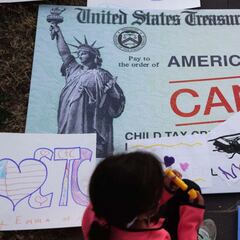Why is the Federal Reserve cutting back stimulus? How will this affect stimulus check payments?
The Federal Reserve has confirmed that it intends to reduce the level of financial stimulus in the US economy in the coming months to help combat inflation.


The Federal Reserve has confirmed its intention to reduce the level of financial stimulus ahead of schedule to help combat the rising inflation rate. The move has no direct bearing on the fate of the fourth stimulus check, but does suggest that more direct payments are unlikely.
Throughout the pandemic the United States’ central bank has been using economic mechanisms to maintain a level of financial stimulus in the American economy. This was designed to give the pandemic-stricken economy a boost but there is concern that the measures may have exacerbated inflation.
The move was announced on Wednesday, with some suggestions that the stimulus could end by March 2022 and interest rates could begin to rise again next year having been limited for the past 18 months.
Federal Reserve officials signaled they were prepared to raise interests rates three times next year and begin winding down pandemic stimulus efforts https://t.co/SLdgzohkqk #WSJWhatsNow pic.twitter.com/jMKMj2qOIG
— The Wall Street Journal (@WSJ) December 15, 2021
“Economic developments and changes in the outlook warrant this evolution of monetary policy, which will continue to provide appropriate support for the economy,” Chairman Jerome Powell told reporters on Wednesday.
“Supply and demand imbalances related to the pandemic and the reopening of the economy have continued to contribute to elevated levels of inflation."
What is the Federal ‘taper’ and why does it help?
During the pandemic the Federal Reserve has been making huge purchases of Treasury bonds and mortgage-backed securities to keep money flowing into the economy, which has been devastated by covid-19 and related restrictions.
This system is known as ‘quantative easing’ and was first employed by the Fed in 2008 to combat the financial crisis. Normally a central bank can give a boost to businesses and consumers by lowering the short-term interest rate, but during a recession the rate is at zero and so cannot be reduced further.
Bitcoin jumped above $49,000 on Wednesday, after U.S. Federal Reserve officials approved the acceleration of the central bank’s plan to withdraw coronavirus pandemic stimulus efforts.@MuyaoShen and @JPRubin23 reporthttps://t.co/vXCMoU4mml
— CoinDesk (@CoinDesk) December 15, 2021
And so, in an effort to reduce borrowing costs and stimulate the economy during covid-19, the Fed began buying up Treasury and other securities in March 2020. By November of this year the Fed had purchased more than $4 trillion. The bank will now begin to ‘taper’ those purchases; reducing them gradually so that by March it will have stopped the quantative easing process entirely.
What does this mean for the fourth stimulus check?
Related stories

Will it be possible to receive third stimulus check plus-up payments after 31 December 2021?

Stimulus checks in 2021: how will they affect 2022 tax returns?
The Fed’s stimulus measures are not the same as the stimulus checks sent out to individuals Americans, but the process does employ the same logic. Accordingly, the end of Fed stimulus means that another round of direct payments is increasingly unlikely.
The Federal Reserve is bringing quantative easing to an end due to fears about inflation, which is currently at historic levels. Previous rounds of stimulus checks have been linked to inflation rates increases, so it is unlikely that Congress would push for another round with inflation already such an issue.